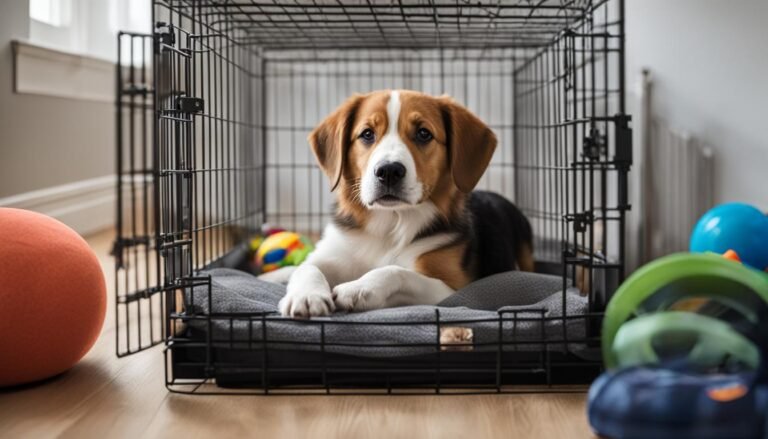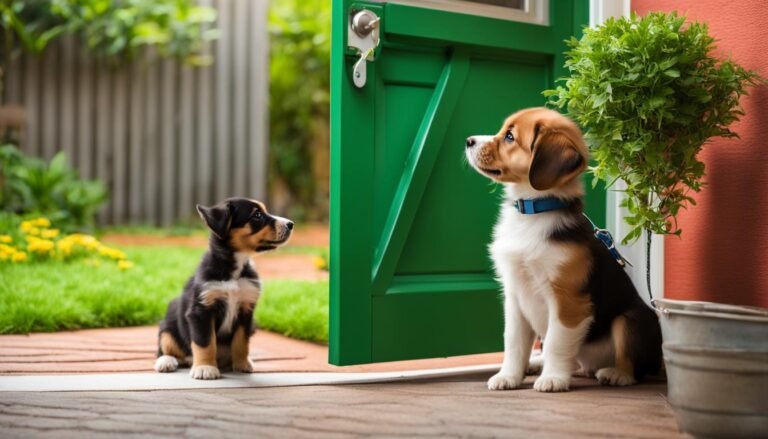How Long to Crate Train a Dog
Are you ready to embark on the journey of crate training your furry friend? It can be both an exciting and daunting task, filled with anticipation and uncertainty. Just like bringing home a new puppy, crate training requires time, patience, and above all, a deep understanding of your dog’s needs.
Think back to the first time you laid eyes on your faithful companion. The way their eyes sparkled with innocence, their tail wagging with joy, and their paws ready to explore the world. You knew in that moment that you would do anything to give them the love and care they deserve.
That’s why crate training is so important. It not only provides a safe and secure space for your dog but also helps them develop good behaviors and habits. But how long does it actually take to crate train a dog? The truth is, there is no one-size-fits-all answer.
The duration of crate training can vary from dog to dog, depending on various factors such as age, temperament, and past experiences. For some dogs, it may only take a few days to get comfortable with the crate, while for others, it may take several weeks. The key is to be patient and observant of your dog’s progress.
Remember, crate training should never be rushed. It’s a gradual process that requires positive reinforcement and trust-building. By creating a positive association with the crate and slowly introducing your dog to it, you can help them feel secure and at ease in their special space.
While crate training is essential, it’s important to avoid leaving your dog in the crate for extended periods of time. Puppies under 6 months of age, in particular, should not stay in the crate for more than three to four hours at a time. Ensuring that your dog gets regular exercise, mental stimulation, and human interaction is crucial for their well-being.
So, whether you’ve just welcomed a new puppy into your home or you’re working on crate training an older dog, remember that each dog is unique and may require different amounts of time and patience. Embrace the journey, and before you know it, your furry friend will feel right at home in their cozy crate.
Proper Use of Crates for Dogs
When it comes to crate training your furry friend, it’s important to understand the proper use of crates. Crates should never be used for punishment; instead, they should be utilized to manage your dog’s behavior effectively. With the right approach, crates can be a helpful tool in preventing mishaps, such as accidents with food or excessive jumping, especially when guests come over.
One essential aspect of crate training is creating a positive association between your dog and the crate. You can use treats or toys to entice your dog into the crate, making it an inviting and comfortable space for them. It’s crucial to avoid leaving your dog in the crate for extended periods of time, as it can lead to a lack of exercise and social interaction, which may negatively impact their overall well-being.
If you need to be away from home for an extended period, consider changing your dog’s schedule, hiring a pet sitter, or taking them to a reputable daycare facility. These alternatives can provide your dog with the necessary exercise, mental stimulation, and human interaction they need to thrive.
Remember, crates aren’t the only option for managing your dog’s behavior. Another effective method is tethering your dog in a small space within your bedroom. This can prevent accidents while still allowing your dog some freedom of movement and access to their essentials.
As your dog becomes more accustomed to being confined, you can gradually transition them from the crate to an enclosed area of the house. Eventually, when they consistently exhibit good behavior, they can have access to the entire house when left alone.
Selecting and Introducing a Crate
When it comes to crate training your dog, selecting the right crate is essential. There are various types of crates available, including plastic, fabric on a collapsible frame, and collapsible metal pens. Consider the specific needs and preferences of your dog when choosing a crate.
The crate should be spacious enough for your dog to stand up and comfortably turn around in. For growing dogs, an adjustable crate can be an ideal choice, as it can be modified to accommodate their size as they continue to grow.
Introducing your dog to the crate should be done gradually to ensure a positive experience. Make the crate a comfortable space by placing a soft blanket or bed inside. You can entice your dog to enter the crate by using treats or toys, creating a positive association with the crate.
Another effective way to introduce the crate is by feeding your dog their meals near the crate. This helps them associate the crate with positive experiences and reinforces the idea that it is a safe and enjoyable place.
Step-by-Step Crate Training Process
The crate training process consists of several steps that will help your dog become comfortable and relaxed in their crate. By following these steps, you can ensure a smooth and successful crate training experience.
1. Introduce the crate
Start by placing the crate in an area where your family spends a lot of time. Keep the door open and secured at first, allowing your dog to explore the crate at their own pace. Use treats or toys to encourage them to enter the crate willingly.
2. Associate the crate with positive experiences
During mealtime, move your dog’s food dish closer to the crate. As they become comfortable eating near the crate, gradually move the dish further back inside the crate. This will create a positive association between the crate and mealtime.
3. Close the door for short periods
Once your dog is comfortable eating in the crate, start closing the door for short periods of time while you are still at home. Stay in the room and engage with your dog to provide reassurance and prevent any anxiety. Gradually increase the duration that your dog spends in the crate with the door closed, always ensuring they are comfortable and calm.
4. Extend crate time when you are away
Once your dog is comfortable being crated while you are home, you can start leaving them in the crate when you leave the house or at night. Start with short durations and gradually increase the amount of time they spend in the crate. Remember to provide your dog with mental and physical stimulation before crating them, such as exercise and playtime.
5. Be patient and consistent
Crate training takes time and patience. Each dog is unique, so the duration of the training process may vary. Be consistent with your training routine, ensuring that your dog has plenty of positive experiences in the crate. Do not rush the process or force your dog into the crate. Remember to always reward your dog with treats, toys, or praise when they enter the crate willingly.
By following these step-by-step guidelines, you can successfully crate train your dog and provide them with a safe and comfortable space of their own. Just remember to be patient, consistent, and always prioritize your dog’s well-being and comfort.

Managing Whining and Separation Anxiety
During crate training, it is common for dogs to exhibit whining behavior. It is crucial to address this issue appropriately in order to ensure a positive training experience for both you and your furry friend. Whining can have different meanings, so it’s important to determine whether your dog needs to go outside to eliminate or if they are simply testing the boundaries of the crate.
One approach recommended by experts is to ignore the whining unless it persists. If the whining continues, you can use a specific phrase associated with going outside to gauge whether your dog actually needs to go out. This can help you distinguish between a genuine need and simple attention-seeking behavior.
When it comes to separation anxiety, it’s important to note that using the crate as a solution can sometimes exacerbate the issue. If your dog already experiences separation anxiety, confining them in a crate may intensify their anxiety and distress. In these cases, it is best to address separation anxiety separately, using counterconditioning and desensitization techniques.
If your dog’s separation anxiety is severe or persistent, it may be beneficial to seek guidance from a professional animal behavior specialist. They can provide valuable insights and create a tailored plan to address your dog’s specific needs.

Remember, managing whining and separation anxiety during crate training requires patience and understanding. By addressing these issues empathetically and seeking professional guidance when needed, you can create a positive training experience and help your dog feel safe and comfortable in their crate.
Crate Training Tips and Best Practices
Enhancing the crate training experience for your pet involves implementing several tips and best practices. Follow these guidelines to ensure smooth and effective crate training for your canine companion.
- Choose the Right Crate: Select a crate that is suitable for your dog’s size, considering factors such as durability, comfort, and flexibility. Avoid using a crate that is too big, as it may encourage your dog to use one corner as a bathroom area.
- Use a Divider: If you have a growing puppy, opt for an adjustable crate with a divider that allows you to customize the space as your pet grows. A properly sized crate provides a snug and secure environment, making your dog feel safe and secure.
- Establish a Relaxed Mindset: During crate training, help your dog associate the crate with rest and calmness. Use positive reinforcement techniques and create a soothing atmosphere by placing comfortable bedding and a soft blanket inside the crate.
- Reward with Toys or Treats: Encourage your dog to enter the crate willingly by offering treats, toys, or engaging games. This positive association will help your pet understand that the crate is a desirable space.
- Provide Regular Breaks: Remember to allocate dedicated time for outside the crate activities such as play, exercise, feeding, and bathroom breaks. This ensures that your dog receives sufficient physical and mental stimulation.
- Incorporate Crate Games: Engage your dog in mental stimulation and build a positive association with the crate by incorporating crate games. This can include hiding treats or puzzle toys inside the crate, encouraging your dog to explore and interact with the space.
- Collar and Tag-Free: To prevent any accidents or discomfort, remove your dog’s collar and tags before placing them in the crate. This eliminates the possibility of entanglement and ensures a safe and secure crate environment.
By implementing these crate training tips and best practices, you can create a positive and comfortable association between your dog and their crate, making the training process smoother and more enjoyable for everyone involved.
Patience and Success in Crate Training
Crate training is a process that requires patience and consistency. While every dog is unique, it generally takes at least six months to fully crate train a dog. It’s important to keep in mind that there may be ups and downs along the way, but staying calm and consistent in your training approach is key to achieving success.
During the crate training journey, patience and rewards play crucial roles. As you introduce your dog to the crate and associate it with positive experiences, they will gradually become more comfortable and look forward to the rewards and the opportunity to rest in their designated space.
One helpful tool in monitoring your dog’s progress is the use of remote dog cameras. These cameras allow you to keep an eye on your furry friend while you’re away, providing valuable insights into their behavior and how they’re adjusting to the crate.






